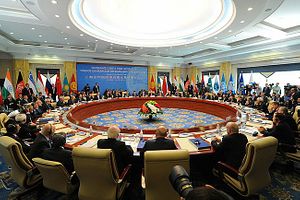For months, as Russia’s fiscal downturn and economic protectionism dragged Central Asian economies down with it, China has continued to ratchet up investments in the region. Slowly, methodically, Beijing has surpassed Russia as the region’s most substantive trading partner. Moreover, China has managed to wrangle a chokehold on Central Asian gas through its expanding China-Central Asia pipeline matrix. Not only will the pipeline network soon be providing at least 40 percent of China’s imported gas, but Central Asian gas exports to Russia – the traditional destination for the region’s gas –have dropped nearly 60 percent since the pipeline first came online in 2009, including a 74 percent collapse from Turkmenistan.
Under the dual “March Westward” and “Silk Road Economic Belt” policies, China has effectively boxed Russia out as the region’s preferred economic partner. And now, after the latest round of proposed investments, this reality has become that much starker – and Western media is finally starting to take notice.
In an article titled “Putin is Losing Out to China in Central Asia’s Latest ‘Great Game,’” Bloomberg details the means and mechanisms with which Beijing has managed to redirect Central Asia’s economic trajectory from its former colonizer to a new patron. Among the instruments with which Beijing has cultivated Central Asian relations is a new $16.3 billion fund “to finance railways, roads, and pipelines across Central Asia.” While specific projects within this fund’s purview have not yet been detailed, the fund, managed by Chinese policy banks, will help enhance the proposed resuscitation of former Silk Road routes.
As it is, the fund appears part of a $40 billion “Silk Road Fund” President Xi Jinping announced in early November. According to Xinhua, this fund will come split between the aforementioned Silk Road Economic Belt and the proposed 21st century Maritime Silk Road initiative. Though details on the fund’s management and timeline remain unclear, Xi noted that the fund would “break the bottleneck in Asian connectivity” and provide “inter-connectivity training” for some 20,000 citizens of member-countries through 2019.
Among the foremost recipients of Chinese largesse – and one of the primary nations whose underlying economics are pivoting from Moscow to Beijing – is Tajikistan. As Tajik Deputy Finance Minister Jamoliddin Nuraliev recently told the Financial Times, China will be investing at least $6 billion in Tajikistan’s infrastructure through 2017. Not only is the figure nearly 70 percent of Tajikistan’s 2013 GDP, but, per FT, it is “more than 40 times [Tajikistan’s] annual foreign direct investment.”
And this is where Russia’s economic misadventures come into play. While at one point approximately half of Tajikistan’s GDP came from remittances of migrant labor in Russia, the number has begun dropping – with officials estimating that the rate has fallen by as much as 20 percent over the past few months. As Nuraliev noted, “We are very much concerned about things happening in the Russian economy.” Moreover, when juxtaposed with China’s ten-figure proposal – set for pipeline expansion, as well as cement and rail investments – the recent Russian pledge of $6.7 million to Tajikistan looks that much more meager.
Of course, Tajikistan will not be the sole recipient of China’s coming assistance – but the pivot, now accelerating toward Beijing, runs clear through Dushanbe. Following Xi’s 2013 swing through Central Asia, regional scholar Martha Brill Olcott observed that “Russia can no longer effectively counter China’s economic ties with its Central Asian neighbors.” In the 14 months since, the divergence has only accelerated. Trade relations between Russia and its former Central Asian colonies has nosedived – as has Moscow’s relations with Astana, following on the heels of Russia’s invasion of southern Ukraine. All the while, China has continue to pile deal upon deal, with even greater cooperation coming. Russia’s losses continues to be China’s – and, by extent, Central Asia’s – gain.

































